Social Interaction: A Crucial Means to Promote Sustainability in Initial Teacher Training
Abstract
1. Introduction
1.1. Integrating Sustainability in Teacher Training
1.2. Social Interaction as a Learning Principle and Driver of Change
1.3. Training Context
- (a)
- (b)
- (c)
- Analysis, reflection and criticism. A strategy of introspection, awareness of needs, access, selection and organisation of data [53].
- (d)
- In the first reflective moment related to LMK, the students prepare a descriptive summary and a conceptual map of each area of curricular knowledge involved in groups of 4 or 5 members.
- During the second reflective moment, LMK learning is approached using two areas of attention, the cognitive characteristics of the students of the degree in ECE and the possible learning principles. The work of important authors in the field of learning, such as Piaget, Vygotsky, Ausubel and Perret-Clermont, was analysed in the subject of DMKECE in which the study took place.
- The third reflective moment focuses on teaching LMK and addresses the teacher’s role [56], principles of performance, organisation of the classroom and activities organised in different spaces at different times (routines, corners and workshops), as well as the PBL methodology.
2. Materials and Methods
2.1. Research Question, Objectives and Participants
- Identify whether or not the student teachers consider the value and usefulness of social interactions in learning;
- Identify, describe and understand how pre-service teachers describe and justify the importance of social interaction as a means to promote LMK learning.
2.2. Data Collection Procedure. Instruments
2.3. Data Processing and Analysis
3. Results
3.1. Social Dimension of Learning (C1)
3.2. The Role of Language in Learning (C2)
3.3. The Role of Socio-Cognitive Conflict in Learning (C3)
3.4. The Role of Horizontal Interaction (Student-Student) in Learning (C4)
3.5. The Role of Vertical Interaction (Teacher-Student) in Learning (C5)
3.6. Global Presence of the Categories (C1–C5)
4. Discussion of Results
4.1. Sustainability Attributes Related to the Identification and Understanding of Social Interaction as a Learning Principle (C1)
4.2. Sustainability Attributes Related to the Identification and Understanding of the Role of Language in Learning (C2)
4.3. Sustainability Attributes Related to the Identification and Understanding of the Role of Cognitive Conflict in Learning (C3)
4.4. Sustainability Attributes Related to the Identification and Understanding of the Role of Horizontal Interaction (Student-Student) in Learning (C4)
4.5. Sustainability Attributes Related to the Identification and Understanding of the Role of Vertical Interactions (Teacher-Student) in Learning (C5)
5. Conclusions
Author Contributions
Funding
Institutional Review Board Statement
Informed Consent Statement
Data Availability Statement
Acknowledgments
Conflicts of Interest
References
- UNESCO. Educación Para Los Objetivos de Desarrollo Sostenible: Objetivos de Aprendizaje; UNESCO: Paris, France, 2017; Available online: https://unesdoc.unesco.org/ark:/48223/pf0000252423 (accessed on 30 July 2021).
- McKeown, R. Education for Sustainable Development Toolkit; University of Tennessee: Knoxville, TN, USA, 2002; Available online: https://www.ramsar.org/sites/default/files/documents/library/esd_toolkit_version_2.pdf (accessed on 30 July 2021).
- Rieckmann, M. Future-oriented higher education: Which key competencies should be fostered through university teaching and learning? Futures 2012, 44, 127–135. Available online: https://papers.ssrn.com/sol3/papers.cfm?abstract_id=2035441 (accessed on 30 July 2021). [CrossRef]
- Geli, A.M.; Collazo, L.; Mulà, I. Contexto y evolución de la sostenibilidad en el curriculum de la universidad española. Rev. De Educ. Ambient. Y Sostenibilidad 2019, 1, 1102. [Google Scholar] [CrossRef]
- De la Rosa, D.; Giménez, P.; De la Calle, C. Educación para el desarrollo sostenible: El papel de la universidad en la agenda 2030. Transformación y diseño de nuevos aprendizajes. Prism. Soc. 2019, 25, 179–202. Available online: https://revistaprismasocial.es/article/view/2709 (accessed on 30 July 2021).
- Cereceda, R.C.; Hernández, S.R.; Rivera, E.D.O. Los Objetivos de Desarrollo Sostenible y los retos para su implementación. Plur. Y Consenso 2016, 5, 55–84. Available online: http://revista.ibd.senado.gob.mx/index.php/PluralidadyConsenso/article/view/295/298 (accessed on 30 July 2021).
- Wiek, A.; Withycombe, L.; Redman, C.L. Key competencies in sustainability: A reference framework for academic program development. Sustain. Sci. 2011, 6, 203–218. [Google Scholar] [CrossRef]
- Del Álamo, J.B.; Marcén, C.; Hidalgo, D.A.; Gutiérrez, J.M. Educación Para la Sostenibilidad en España. Reflexiones y Propuestas Bastida Documento de Trabajo Opex N° 86/2017; Fundación Alternativas y Red Española para el Desarrollo Sostenible: Madrid, Spain, 2017; Available online: https://www.miteco.gob.es/es/ceneam/recursos/pag-web/educacion-sostenibilidad-espana.aspx (accessed on 30 July 2021).
- Rychen, D.S.; Salganik, L.H. (Eds.) Key Competencies for a Successful Life and Well-Functioning Society; Hogrefe & Huber Publishers: Göttingen, Germany, 2003; Available online: https://pubengine2.s3.eu-central-1.amazonaws.com/preview/99.110005/9781616762728_preview.pdf (accessed on 30 July 2021).
- Sterling, S. Higher education, sustainability, and the role of systemic learning. In Higher Education and the Challenge of Sustainability: Problematics, Promise and Practice; Blaze Corcoran, P.B., Wals, A.E.J., Eds.; Kluwer Academic Press: Dordretch, The Netherlands, 2004; pp. 49–70. [Google Scholar] [CrossRef]
- GESU-CRUE-Sostenibilidad. Diagnóstico de la Sostenibilidad Ambiental en las Universidades Españolas. Informe 2019; Grupo de Evaluación de la Sostenibilidad Universitaria (GESU) de Crue Sostenibilidad: Madrid, Spain, 2019; Available online: http://www.sga.uma.es/images/GESU-informe-sostenibilidad-2019.pdf (accessed on 30 July 2021).
- Zamora-Polo, F.; Sánchez-Martín, J. Teaching for a better world. Sustainability and Sustainable Development Goals in the construction of a change-maker university. Sustainability 2019, 11, 4224. [Google Scholar] [CrossRef]
- Stephens, J.C.; Hernandez, M.E.; Román, M.; Graham, A.C.; Scholz, R.W. Higher education as a change agent for sustainability in different cultures and contexts. Int. J. Sustain. High. Educ. 2008, 9, 317–338. [Google Scholar] [CrossRef]
- Shephard, K.; Furnari, M. Exploring what university teachers think about education for sustainability. Stud. High. Educ. 2013, 38, 1577–1590. [Google Scholar] [CrossRef]
- Poza-Vilches, F.; López-Alcarria, A.; Mazuecos-Ciarra, N. ‘A professional competences’ diagnosis in education for sustainability: A case study from the standpoint of the education guidance service (EGS) in the Spanish context. Sustainability 2019, 11, 1568. [Google Scholar] [CrossRef]
- Sinakou, E.; Boeve-de Pauw, J.; Goossens, M.; Van Petegem, P. Academics in the field of education for sustainable development: Their conceptions of sustainable development. J. Clean. Prod. 2018, 184, 321–332. Available online: https://agris.fao.org/agris-search/search.do?recordID=US201800388584 (accessed on 30 July 2021). [CrossRef]
- Scott, W. Education for sustainable development (ESD): A critical review of concept, potential and risk. In Schooling for Sustainable Development; Jucker, R., Mathar, R., Eds.; Springer International Publishing: Cham, Switzerland, 2015; pp. 47–70. [Google Scholar]
- Rieckmann, M. Learning to transform the world: Key competencies in Education for Sustainable Development. In Issues and Trends in Education for Sustainable Development; Leicht, A., Heiss, J., Byun, W.J., Eds.; Unesco: Paris, France, 2018; pp. 39–60. [Google Scholar]
- Lozano, R.; Merrill, M.Y.; Sammalisto, K.; Ceulemans, K.; Lozano, F.J. Connecting competences and pedagogical approaches for sustainable development in higher education: A literature review and framework proposal. Sustainability 2017, 9, 1889. [Google Scholar] [CrossRef]
- Cardeñoso, J.M.; Cuesta, J.; Azcárate, P. Un instrumento para analizar las actividades prácticas en la formación inicial del profesorado de Secundaria de Ciencias y Matemáticas desde la perspectiva de la sostenibilidad. Rev. Eureka Sobre Enseñanza Divulg. Cienc. 2015, 12, 109–129. [Google Scholar] [CrossRef]
- Gopalakrishnan, A.C.; Bhaskaran, S.; Ambujakshi, S. Relationship between proactivity and personal pedagogical knowledge in esd among pre-service teachers: Sub-sampling on social media usage and subject discipline. J. Teach. Educ. Sustain. 2019, 21, 73–90. [Google Scholar] [CrossRef]
- Sterling, S. The Future Fit Framework: An Introductory Guide to Teaching and Learning for Sustainability in HE (Guide). J. Educ. Sustain. Dev. 2013, 7, 134–135. [Google Scholar] [CrossRef]
- Gilomen, H. Desired outcomes: A successful life and well-functioning society. In Key Competencies for a Succesful Life and Wellfunctioning Society; Rychen, D.S., Salganik, L.H., Eds.; Hogrefe & Huber: Gottingen, Germany, 2003; pp. 109–134. [Google Scholar]
- Barth, M.; Godemann, J.; Rieckmann, M.; Stoltenberg, U. Developing key competencies for sustainable development in higher education. Int. J. Sustain. High. Educ. 2007, 8, 416–430. Available online: https://ssrn.com/abstract=1978290 (accessed on 30 July 2021). [CrossRef]
- Trencher, G.; Vincent, S.; Bahr, K.; Kudo, S.; Markham, K.; Yamanaka, Y. Evaluating core competencies development in sustainability and environmental master’s programs: An empirical analysis. J. Clean Prod. 2018, 181, 829–841. [Google Scholar] [CrossRef]
- Albareda-Tiana, S.; Ruíz-Morales, J.; Azcárate, P.; Valderrama-Hernández, R.; Muñoz, J.M. The EDINSOST Project: Implementing the Sustainable Development Goals at University Level. In Universities as Living Labs for Sustainable Development: Supporting the Implementation of the Sustainable Development Goals; Leal Filho, W., Salvia, A.L., Petrorius, R., Brandli, L., Manolas, E., Alves, M.F.P., Azeiteiro, U., Rogers, J., Shiel, C., Paço, A., Eds.; Springer: Berlín, Germany, 2019; pp. 193–210. [Google Scholar] [CrossRef]
- Kalsoom, Q.; Khanam, A. Inquiry into sustainability issues by preservice teachers: A pedagogy to enhance sustainability consciousness. J. Clean. Prod. 2017, 164, 1301–1311. [Google Scholar] [CrossRef]
- García-González, E.; Jiménez-Fontana, R.; Navarrete, A.; Azcárate, P. La metodología docente como estrategia para promover la sostenibilidad en las aulas universitarias. Un estudio de caso en la Universidad de Cádiz. Foro de Educación 2015, 13, 85–124. [Google Scholar] [CrossRef]
- Alghamdi, N.; Den Heijer, A.; De Jonge, H. Assessment tools’ indicators for sustainability in universities: An analytical overview. Int. J. Sustain. High. Educ. 2017, 18, 84–115. [Google Scholar] [CrossRef]
- Rivero, A.; Porlán, R.; Azcárate, P.; del Pozo, R.M.; Harres, J. The Progression of Prospective Primary Teachers’ Conceptions of the Methodology of Teaching. Res. Sci. Educ. 2011, 41, 739–769. [Google Scholar] [CrossRef]
- Barth, M.; Rieckmann, M. Academic staff development as a catalyst for curriculum change towards education for sustainable development: An output perspective. J. Clean. Prod. 2012, 26, 28–36. [Google Scholar] [CrossRef]
- Morin, E. La vía Para el Futuro de la Humanidad; Reis: Barcelona, Spain, 2011. [Google Scholar]
- Rowe, D. Education for a sustainable future. Science 2007, 317, 323–324. [Google Scholar] [CrossRef] [PubMed]
- McArthur, J.W.; Sachs, J. Needed: A new generation of problem solvers. Chron. High Educ. 2009, 55, A64–A66. Available online: https://www.chronicle.com/article/needed-a-new-generation-of-problem-solvers/ (accessed on 30 July 2021).
- UNESCO. La Educación en un Mundo Tras la COVID: Nueve Ideas Para la Acción Pública. Comisión Internacional Sobre los Futuros de la Educación; UNESCO: Paris, France, 2020; Available online: https://www.buenosaires.iiep.unesco.org/es/node/929 (accessed on 30 July 2021).
- Byrne, J. From policy to practice: Creating education for a sustainable future. In Education for a Sustainable Future: A Paradigm of Hope for the 21st Century; Wheeler, K.A., Bijur, A.P., Eds.; Kluwer/Plenum: New York, NY, USA, 2000; pp. 35–72. [Google Scholar]
- Sipos, Y.; Battisti, B.; Grimm, K. Achieving transformative sustainability learning: Engaging heads, hands and heart. Int. J. Sustain. High. Educ. 2008, 9, 68–86. [Google Scholar] [CrossRef]
- Cardeñoso, J.M.; Moreno, A.; García-González, E.; Jiménez-Fontana, R. El sesgo de equiprobabilidad como dificultad para comprender la incertidumbre en futuros docentes argentinos. Av. Investig. Educ. Matemática 2017, 11, 145–166. [Google Scholar] [CrossRef]
- Samuelsson, I.P.; Kaga, Y. La educación en la primera infancia para transformar el modelo cultural hacia la sostenibilidad. In La situación del mundo 2010. Cambio Cultural: Del Consumismo Hacia la Sostenibilidad. (Informe Anual del Worldwatch Institute Sobre Progreso Hacia una Sociedad Sostenible); The World Watch Institut, Icaria Editorial: Barcelona, Spain, 2010; pp. 125–132. [Google Scholar]
- Vygotsky, L.S. Interaction between learning and development. In Mind in Society: Development of Higher Psychological Processes; Cole, M., John-Steiner, V., Scribner, S., Souberman, E., Eds.; Harvard University Press: Cambridge, MA, USA, 1978; pp. 79–91. Available online: http://ouleft.org/wp-content/uploads/Vygotsky-Mind-in-Society.pdf (accessed on 30 July 2021).
- Alsina, A.; Domingo, M. Idoneidad didáctica de un protocolo sociocultural de enseñanza y aprendizaje de las matemáticas. Rev. Latinoam. Investig. Matemática Educ. 2010, 13, 7–32. Available online: http://www.scielo.org.mx/scielo.php?script=sci_arttext&pid=S1665-24362010000100002 (accessed on 30 July 2021).
- Doise, W.; Mugny, G.; Perret-Clermont, A.N. Social interaction and cognitive development: Further evidence. Eur. J. Soc. Psychol. 1976, 6, 245–247. [Google Scholar] [CrossRef]
- Lee, C.K. An overview of language learning strategies. Annu. Rev. Educ. Commun. Lang. Sci. ARECLS 2010, 7, 132–152. Available online: https://core.ac.uk/download/pdf/25889647.pdf (accessed on 30 July 2021).
- Mercer, N. Sociocultural discourse analysis: Analysing classroom talk as a social mode of thinking. J. Appl. Linguist. 2004, 1, 137–168. [Google Scholar] [CrossRef]
- Aznar Minguet, P.; Ull Solís, A. Educación y Sostenibilidad en la Universidad de Valencia: Construyendo futuro desde el pasado. Rev. Educ. Ambient. Sostenibilidad 2019, 1, 1202. [Google Scholar] [CrossRef]
- Walker, M. ¿Aptitudes y qué más? Principios para las pedagogías de praxis en la educación superior. In Ponencias del VI Congreso Universidad y Cooperación al Desarrollo; Centro de Cooperación al Desarrollo, Ed.; Universidad y Educación para el Desarrollo: Valencia, Spain, 2011; pp. 5–19. Available online: https://dspace.ups.edu.ec/handle/123456789/8358 (accessed on 30 July 2021).
- Paredes, S.; Cáceres, M.J.; Diego-Mantecón, J.M.; Blanco, T.F.; Chamoso, J.M. Creating Realistic Mathematics Tasks Involving Authenticity, Cognitive Domains, and Openness Characteristics: A Study with Pre-Service Teachers. Sustainability 2020, 12, 9656. [Google Scholar] [CrossRef]
- Qablan, A. Building capacities of educators and trainers. In Issues and Trends in Education for Sustainable Development; Leicht, A., Heiss, J., Byun, W.J., Eds.; Unesco: Paris, France, 2018; pp. 133–156. Available online: https://unesdoc.unesco.org/ark:/48223/pf0000261445 (accessed on 30 July 2021).
- Blumenfeld, P.C.; Soloway, E.; Marx, R.W.; Krajcik, J.S.; Guzdial, M.; Palincsar, A. Motivating project-based learning: Sustaining the doing, supporting the learning. Educ. Psychol. 1991, 26, 369–398. [Google Scholar] [CrossRef]
- Roessingh, H.; Chambers, W. Project-based learning and pedagogy in teacher preparation: Staking out the theoretical mid-ground. Int. J. Teach. Learn. High. Educ. 2011, 23, 60–71. Available online: https://files.eric.ed.gov/fulltext/EJ938579.pdf (accessed on 30 July 2021).
- De Haan, G. The BLK ‘21’ programme in Germany: A ‘Gestaltungskompetenz’-based model for education for sustainable development. Environ. Educ. Res. 2006, 1, 19–32. [Google Scholar] [CrossRef]
- Sterling, S.; Thomas, I. Education for sustainability: The role of capabilities in guiding university curricula. Int. J. Innov. Sustain. Dev. 2006, 1, 349–370. Available online: https://ideas.repec.org/a/ids/ijisde/v1y2006i4p349-370.html (accessed on 30 July 2021). [CrossRef]
- Kioupi, V.; Voulvoulis, N. Education for Sustainable Development: A Systemic Framework for Connecting the SDGs to Educational Outcomes. Sustainability 2019, 11, 6104. [Google Scholar] [CrossRef]
- McKeown, R.; Hopkins, C. EE p ESD: Defusing the worry. Environ. Educ. Res. 2003, 9, 117–128. [Google Scholar] [CrossRef]
- Van Dam-Mieras, R.; Lansu, A.; Rieckmann, M.; Michelsen, G. Development of an interdisciplinary, intercultural master’s program in sustainability: Learning from the richness of diversity. Innov. High. Educ. 2008, 32, 251–264. [Google Scholar] [CrossRef]
- García-González, E.; Jiménez-Fontana, R.; Azcárate, P.; Cardeñoso, J.M. Inclusion of Sustainability in University Classrooms Through Methodology. In Handbook of Theory and Practice of Sustainable Development in Higher Education; Leal Filho, W., Brandli, L., Newman, J., Castro, P., Eds.; Springer International Publishing: Cham, Switzerland, 2017; pp. 3–19. [Google Scholar] [CrossRef]
- Latorre, A.; Rincón, D.; Arnal, J. Bases Metodológicas de la Investigación Educativa; Hurtado Ediciones: Barcelona, Spain, 1997. [Google Scholar]
- Aguirre, J.C.; Jaramillo, L.G. El papel de la descripción en la investigación cualitativa. Cinta Moebio 2015, 53, 175–189. [Google Scholar] [CrossRef]
- Barrantes, R. Investigación: Un Camino al Conocimiento. Un Enfoque Cualitativo, Cuantitativo y Mixto; Editorial EUNED: San José, Costa Rica, 2014. [Google Scholar]
- Flick, U. Introducción a la Investigación Cualitativa; Ediciones Morata y Fundación Paideia Galiza: Madrid, Spain, 2012. [Google Scholar]
- Creswell, J.W.; Plano, C.V.L. Designing and Conducting Mixed Methods Research; SAGE Publications: Los Angeles, CA, USA, 2011. [Google Scholar]
- Hernández, S.R.; Fernández, C.C.; Baptista, L.P. Metodología de la Investigación, 5th ed.; Mc Graw Hill: Mexico City, Mexico, 2010. [Google Scholar]
- Bardin, L. El Análisis del Contenido; Akal: Barcelona, Spain, 1986. [Google Scholar]
- Viegas, C.V.; Bond, A.J.; Vaz, C.R.; Borchardt, M.; Pereira, G.M.; Selig, P.M.; Varvakis, G. Critical attributes of Sustainability in Higher Education: A categorisation from literature review. J. Clean. Prod. 2016, 126, 260–276. [Google Scholar] [CrossRef]
- Bergstrom, A. Sustainability 101: Guiding Students on a Sustainability Journey. Master’s Thesis, University of Alberta, Edmonton, AB, Canada, 2019. [Google Scholar] [CrossRef]
- Kvale, S. Interviews: An Introduction to Qualitative Research Interviewing; SAGE Publications: Los Angeles, CA, USA, 1996. [Google Scholar]
- Strauss, A.L.; Corbin, J. Basics of Qualitative Research: Grounded Theory Procedures and Techniques; SAGE Publications: Los Angeles, CA, USA, 1990. [Google Scholar]
- Sánchez-Barbero, B.; Chamoso, J.M.; Vicente, S.; Rosales, J. Analysis of Teacher-Student Interaction in the Joint Solving of Non-Routine Problems in Primary Education Classrooms. Sustainability 2020, 12, 428. [Google Scholar] [CrossRef]
- Viladot, P.; Pedreira, M. Fer bones pràctiques als musèus i centres de ciències. In Som Educaciò. Ensenyar i Aprende als Mueseus i Centre de Ciència: Una Propuesta de Model Didàctic; Bonil, J., Gómez, T., Pejó, M., Viladot, P., Eds.; Museu de Ciències Naturals de Barcelona, Consorci format per l’Ajuntament de Barcelona i la Generalitat de Catalunya: Barcelona, Spain, 2012; pp. 35–71. Available online: http://issuu.com/museuciencies/docs/manuals_del_museu_vol_1__2012 (accessed on 30 July 2021).
- Ausubel, D. Psicología Educativa, un Punto de Vista Cognoscitivo; Trillas: Mexico City, Mexico, 1978. [Google Scholar]
- Ausubel, D. Adquisición y Retención del Conocimiento; Paidós: Barcelona, Spain, 2002. [Google Scholar]
- Wertsch, J.V. Vygotsky y la Formación Social de la Mente; Paidós: Barcelona, Spain, 1985. [Google Scholar]
- Vygotski, L.S.; Kozulin, A.; Abadía, P.T. Pensamiento y Lenguaje; Paidós: Barcelona, Spain, 1995; pp. 97–115. [Google Scholar]
- Vygotski, L.S.; Cole, M.; Luria, A.R. El Desarrollo de los Procesos Psicológicos Superiores; Crítica: Barcelona, Spain, 1996. [Google Scholar]
- UNESCO. Shaping the Education of Tomorrow; 2012 Report on the UN Decade of Education for Sustainable Development; UNESCO: Paris, France, 2012; Available online: https://desd.in/UNESCO%20report.pdf (accessed on 30 July 2021).
- Perret-Clermont, A.N. La Construction de L’intelligence dans L’intéraction Social; Peter Lang: Bern, Switzerland, 1979; Available online: http://doc.rero.ch/record/324089/files/Perret-Clermont_Anne-Nelly_-_La_construction_de_l_intelligence_sociale_20190211.pdf (accessed on 30 July 2021).
- Perret-Clermont, A.N.; Schubauer-Leoni, M.L. The Social Construction of Meaning in Math Class Interaction. In Paper Presented in the Sixth International Congress on Mathematical Education; Budapest, Hungary. 1988. Available online: http://doc.rero.ch/record/21172?ln=fr (accessed on 30 July 2021).
- Perret-Clermont, A.N.; Schubauer-Leoni, M.L. Social Interactions and Mathematics Learning. In Learning and Teaching Mathematics: An International Perspective; Nunes, T., Bryant, P., Eds.; Psychology Press: Sussex, UK, 1997; pp. 265–283. [Google Scholar]
- Piaget, J. Psicología y Pedagogía; Ariel: Barcelona, Spain, 1972. [Google Scholar]
- Piaget, J. La Psicología de la Inteligencia; Crítica: Barcelona, Spain, 1983. [Google Scholar]
- Larrivee, B. Transforming teaching practice: Becoming the critically reflective teacher. Reflective Pract. 2010, 1, 293–307. [Google Scholar] [CrossRef]
- Olaskoaga-Larrauri, J.; Guerenabarrena-Cortazar, L.; Cilleruelo-Carrasco, E. Academic staff attitudes and barriers to integrating sustainability in the curriculum at Spanish universities. Cult. Educ. 2021, 33, 373–396. [Google Scholar] [CrossRef]
- UNESCO. World Conference on Higher Education. Final Report; UNESCO: Paris, France, 2010; Available online: https://unesdoc.unesco.org/ark:/48223/pf0000189242 (accessed on 30 July 2021).
- Ull, M.Á.; Piñero, A.; Agut, M.P.M.; Minguet, P.A. Preconcepciones y actitudes del profesorado de Magisterio ante la incorporación en su docencia de competencias para la sostenibilidad. Enseñanza Cienc. 2014, 32, 91–112. [Google Scholar] [CrossRef][Green Version]
- Cano Ramírez, A. Exploración de las Prácticas Docentes con Enfoque de Educación para el Desarrollo para la Ciudadanía Global. Aproximación Diagnóstica en los Títulos de Grado de las Universidades Españolas Tras la Implementación del EEES. Ph.D. Thesis, Universidad de Las Palmas de Gran Canaria, Gran Canaria, Spain, 2014. Available online: https://accedacris.ulpgc.es/bitstream/10553/12352/2/0701380_00000_0000.pdf (accessed on 30 July 2021).
- Vásquez, C.; García-Alonso, I.; Seckel, M.J.; Alsina, Á. Education for Sustainable Development in Primary Education Textbooks—An Educational Approach from Statistical and Probabilistic Literacy. Sustainability 2021, 13, 3115. [Google Scholar] [CrossRef]
- Cuesta, J.; Azcarate, P.; Cardeñoso, J.M. The Role of Reflection and Collaboration in the Evolution of a Group of Novice Secondary Education Science Teachers. Aust. J. Teach. Educ. 2016, 41, 136–152. [Google Scholar] [CrossRef]
- CRUE. Directrices Para la Introducción de la Sostenibilidad en el Curriculum; CRUE: Madrid, Spain, 2012; Available online: https://www.crue.org/wp-content/uploads/2020/02/Directrices_Ingles_Sostenibilidad_Crue2012.pdf (accessed on 30 July 2021).
- Englund, T. Deliberative communication: A pragmatist proposal. J. Curric. Stud. 2006, 38, 503–520. [Google Scholar] [CrossRef]
- Wals, A.E.; Jickling, B. “Sustainability” in higher education: From doublethink and newspeak to critical thinking and meaningful learning. Int. J. Sustain. High. Educ. 2002, 3, 221–232. [Google Scholar] [CrossRef]
- Kaasila, R.; Hannula, M.S.; Laine, A. “My Personal Relationship Towards Mathematics Has Necessarily Not Changed But …” Analyzing Preservice Teachers’ Mathematical Identity Talk. Int. J. Sci. Math. Educ. 2012, 10, 975–995. [Google Scholar] [CrossRef]
- Darling-Hammond, L. The right to learn and the advancement of teaching: Research, policy, and practice for democratic education. Educ. Res. 1996, 25, 5–17. [Google Scholar] [CrossRef]
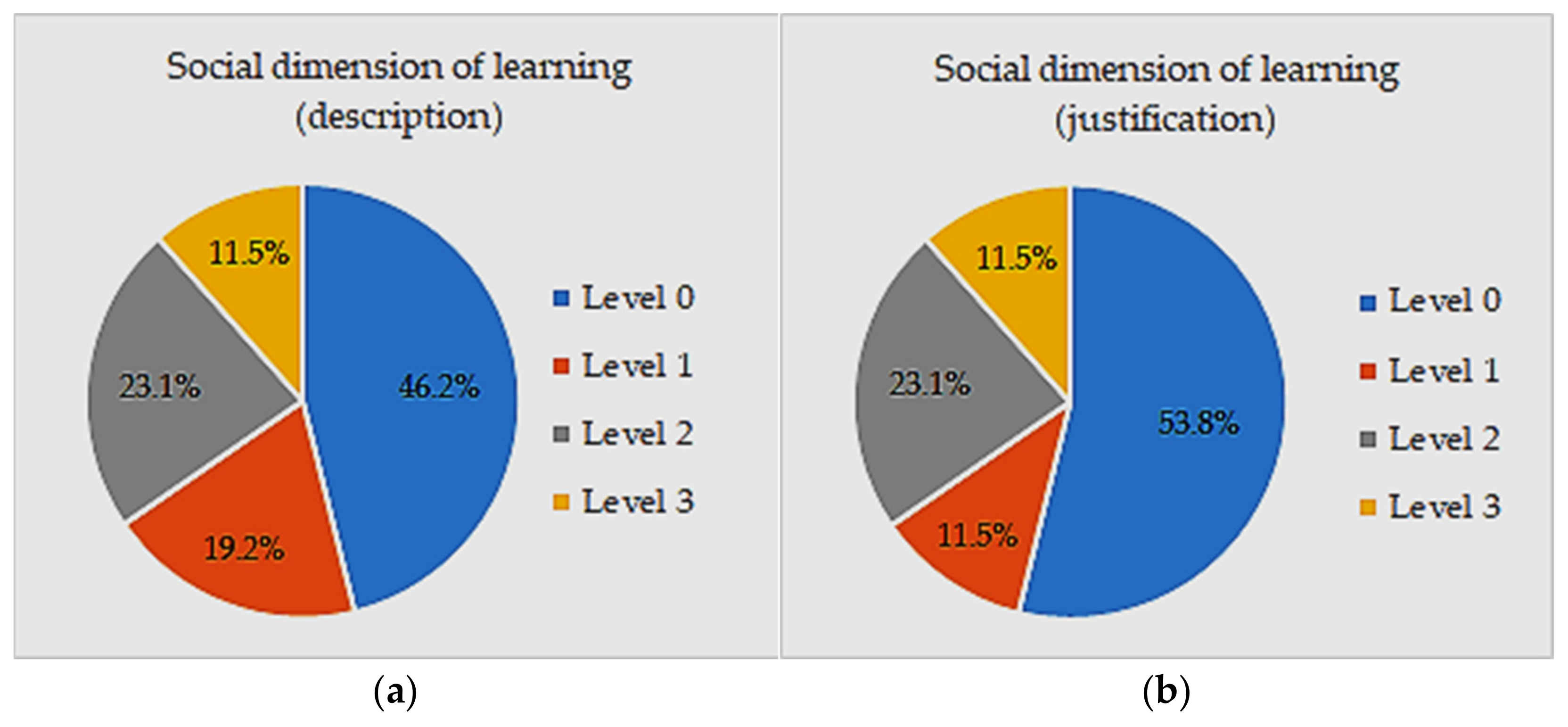
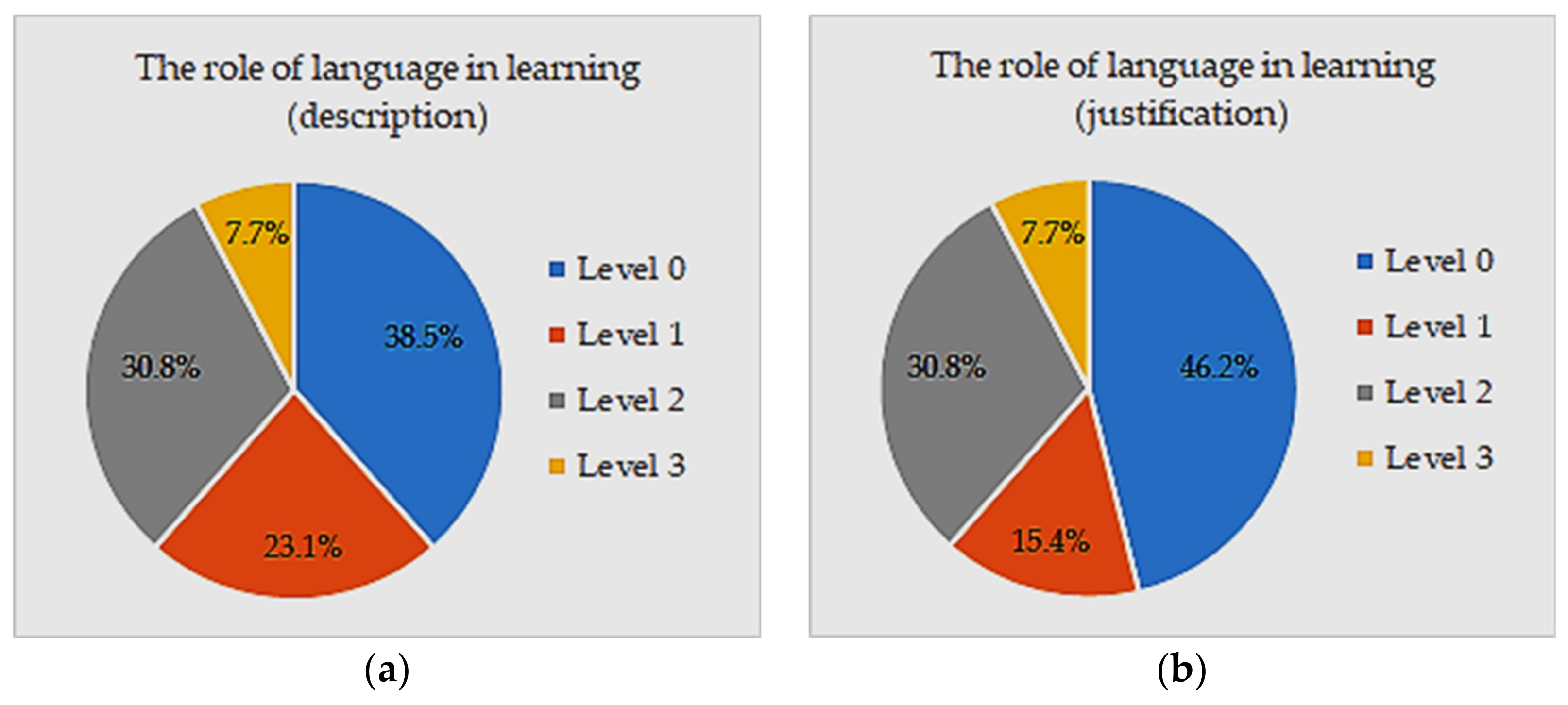
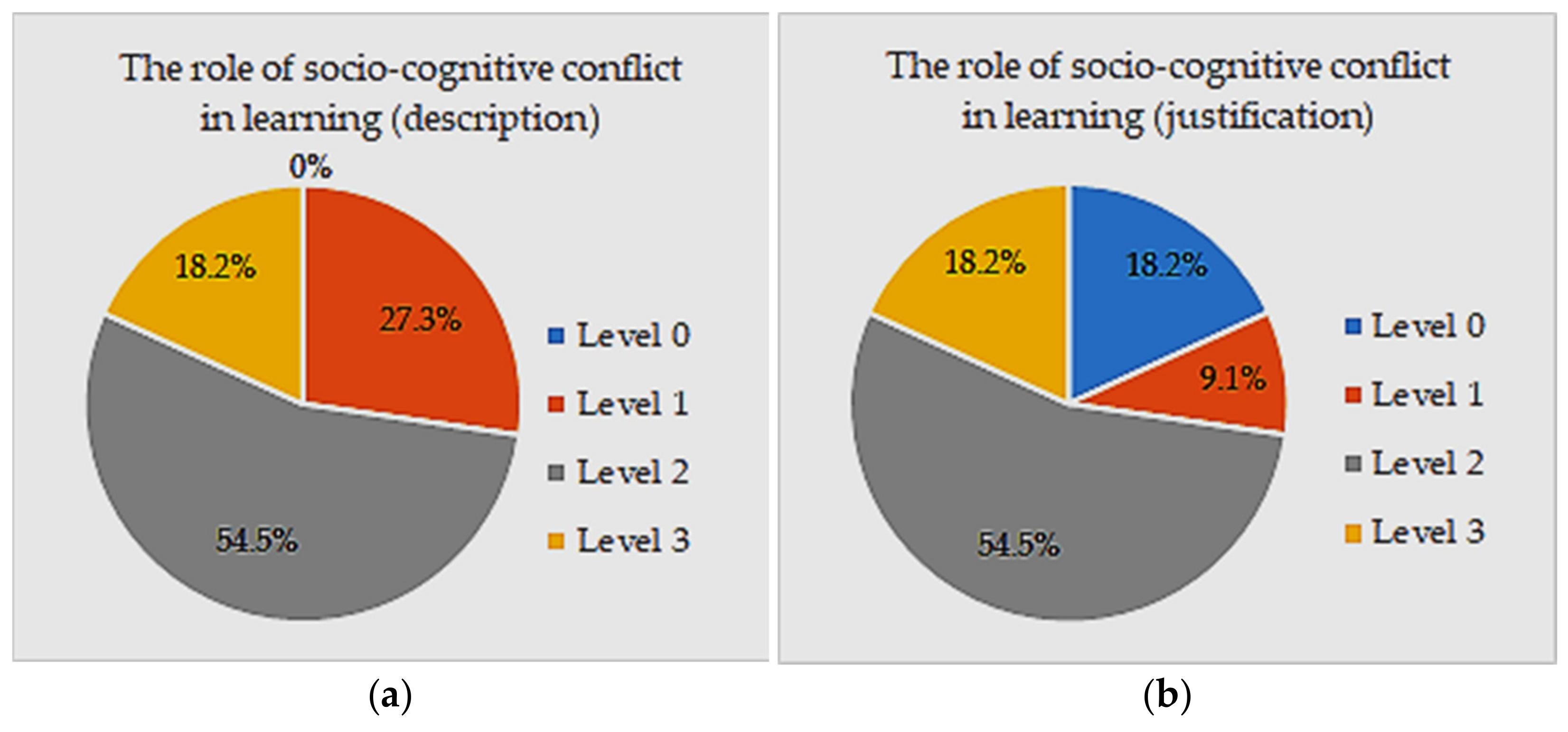

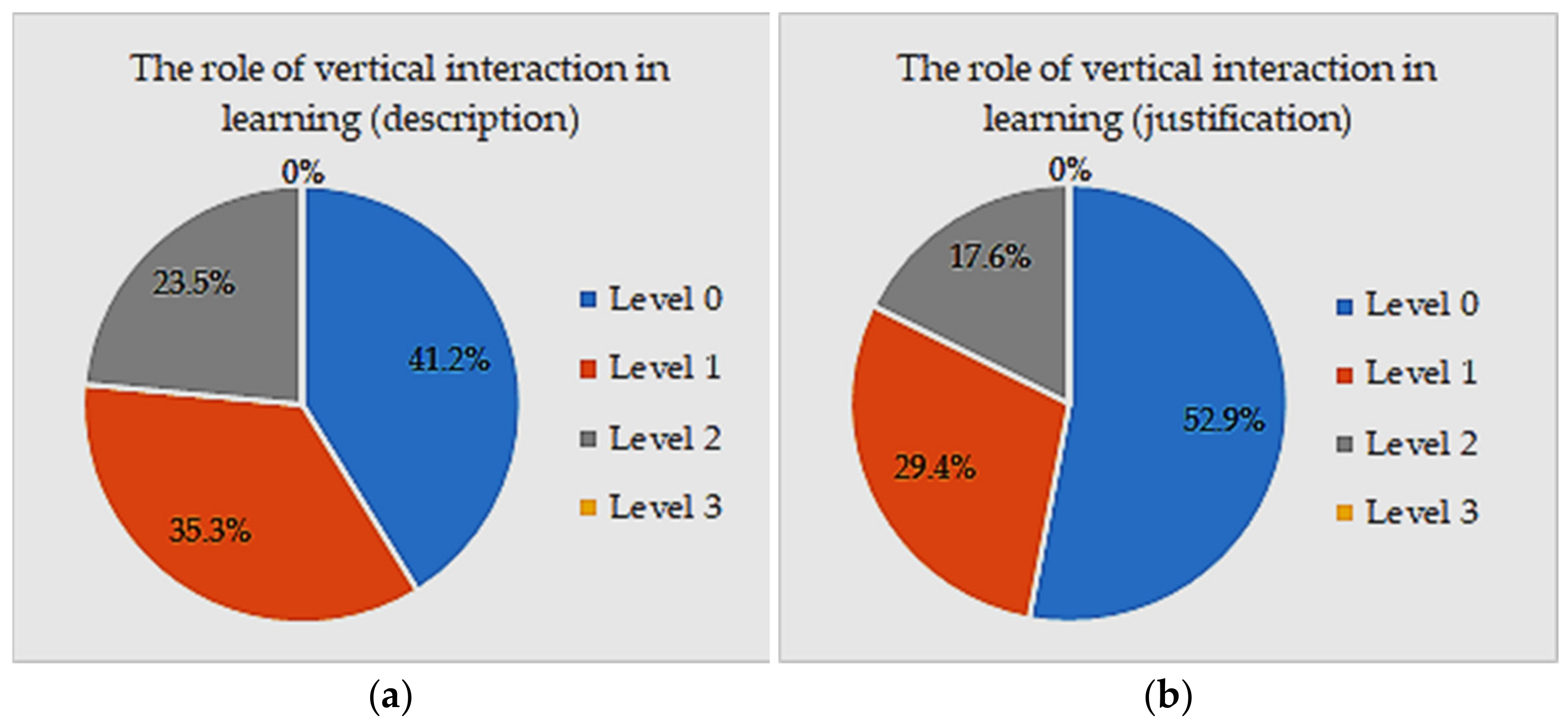
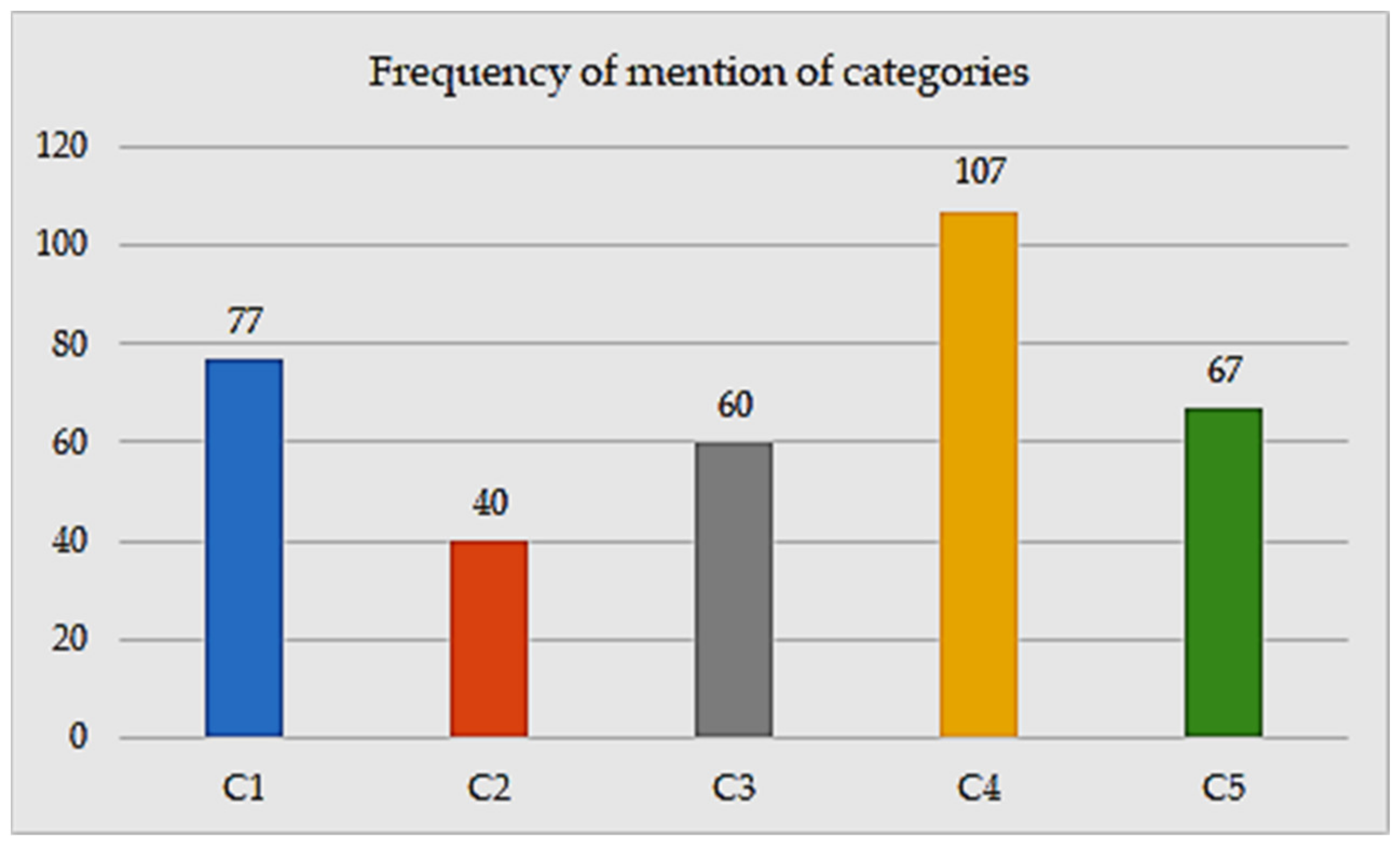

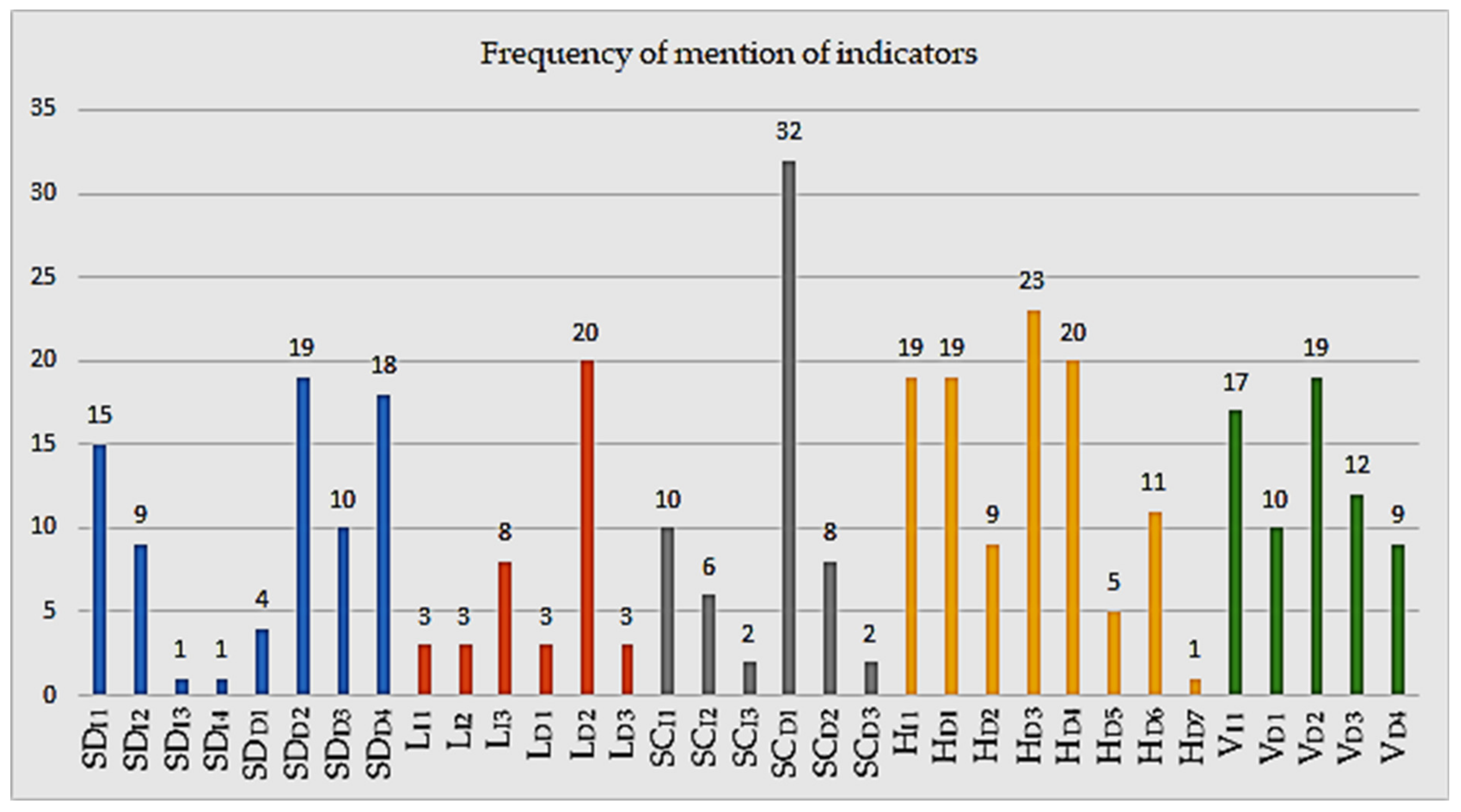
| Categories (C) | Subcategories |
|---|---|
| C1. Social dimension of learning | C1-1. Identification of social interaction as a learning principle |
| C1-2. General description of social interaction as a learning principle | |
| C2. The role of language in learning | C2-1. Identification of the role of language in learning |
| C2-2. Description of the role of language in learning | |
| C3. The role of socio-cognitive conflict in learning | C3-1. Identification of the role of socio-cognitive conflict in learning |
| C3-2. Description of the role of socio-cognitive conflict in learning | |
| C4. The role of horizontal interactions in learning | C4-1. Identification of the role of horizontal interaction in learning |
| C4-2. Description of the role of horizontal interaction in learning | |
| C5. The role of vertical interactions in learning | C5-1. Identification of the role of vertical interaction in learning |
| C5-2. Description of the role of vertical interaction in learning |
| Category | Level 0 | Level 1 | Level 2 | Level 3 |
|---|---|---|---|---|
| Description | No description | Vague or superficial description | In-depth description that does not contemplate some of the expected elements | In-depth description that contemplates all the expected elements |
| Justification | No justification | Vague reference | In-depth reference (related to the work of the main authors used in the subject) | Excellent (in addition to the above, they are able to formulate constructive criticism) |
| C1. Social Dimension of Learning (SD) | ||
|---|---|---|
| C1-1. Identification of social interaction as a learning principle (SDI) | ni | Gi |
| SDI1. Learning is a social phenomenon | 15 | 15 |
| SDI2. Social interaction encourages learning | 9 | 9 |
| SDI3. Learning takes place in a social environment | 1 | 1 |
| SDI4. Knowledge is a social construct | 1 | 1 |
| C1-2. General description of social interaction as a learning principle (SDD) | ni | Gi |
| SDD1. Social dimension of human beings | 4 | 3 |
| SDD2. The social and the cognitive are two dimensions of learning | 19 | 10 |
| SDD3. Zone of potential development (ZPD) | 10 | 7 |
| SDD4. Semiotic mediation (inter-psychic and intra-psychic processes) | 18 | 9 |
| C2. The Role of Language in Learning (L) | ||
|---|---|---|
| C2-1. Identification of the role of language in learning (LI) | ni | Gi |
| LI1. Language is the mediating mechanism of learning | 3 | 2 |
| LI2. Language shapes thinking | 3 | 2 |
| LI3. Communication plays a key role in learning | 8 | 5 |
| C2-2. Description of the role of language in learning (LD) | ni | Gi |
| LD1. Pro-social adaptive answers are biological survival responses. | 3 | 3 |
| LD2. Dialogue, debate and negotiation with others are necessary for learning, as they generate opportunities for restructuring thoughts. | 20 | 9 |
| LD3. Dialogue, debate and negotiation with other environments around questions, content and problem-solving are situations of great value for learning. | 3 | 2 |
| C3. The Role of Socio-Cognitive Conflict in Learning (SC) | ||
|---|---|---|
| C3-1. Identification of the role of socio-cognitive conflict in learning (SCI ) | ni | Gi |
| SCI1. Socio-cognitive conflicts are a source of learning. | 10 | 9 |
| SCI2. Learning starts as a result of the contradictions that arise in social interactions. | 6 | 4 |
| SCI3. Knowledge is built by overcoming obstacles, which manifest themselves through error, and originate in social interaction. | 2 | 2 |
| C3-2. Description of the role of socio-cognitive conflict in learning (SCD) | ni | Gi |
| SCD1. Social expression encourages becoming aware of contradictions, allowing social regulations and consensus. | 32 | 10 |
| SCD2. It starts through dialogue, debate and negotiation with others. | 8 | 8 |
| SCD3. They start through dialogue, debate and negotiation with others about problems, questions and contents. | 2 | 2 |
| C4. The Role of Horizontal Interactions in Learning (H) | ||
|---|---|---|
| C4-1. Identification of the role of horizontal interaction in learning (HI) | ni | Gi |
| HI1. Horizontal interactions promote learning. | 19 | 19 |
| C4-2. Description of the role of horizontal interaction in learning (HD) | ni | Gi |
| HD1. They enable the most skilled students to act as social mediators, encouraging their classmates to act beyond their zone of proximal development. | 19 | 11 |
| HD2. Situations of dialogue, debate and negotiation among peers are a source of learning. | 9 | 8 |
| HD3. They promote communication, collaboration, mutual help and establishing consensus, generating opportunities for the development of social skills and encouraging a sense of belonging to the group. | 23 | 10 |
| HD4. They allow observing answers, proceedings, reasoning, and viewpoints that are different to one’s own. | 20 | 10 |
| HD5. Sharing, cooperating and putting one’s own skills at the service of others enhances students’ motivation and self-esteem. | 5 | 5 |
| HD6. They promote the emergence of socio-cognitive conflicts that enable the construction of knowledge (assimilations and accommodations). | 11 | 8 |
| HD7. Dialogue, debate and negotiation among peers about problem-solving being a privileged means for learning. | 1 | 1 |
| C5. The Role of Vertical Interactions in Learning (V) | ||
|---|---|---|
| C5-1. Identification of the role of vertical interaction in learning (VI) | ni | Gi |
| VI1. Teacher-student interactions are key for learning. | 17 | 16 |
| C5-2. Description of the role of vertical interaction in learning (VD) | ni | Gi |
| VD1. The teacher acts as a social mediator in learning. | 10 | 9 |
| VD2. The help and scaffolding the teacher provide facilitate student learning beyond their zone of proximal development. | 19 | 12 |
| VD3. Situations of dialogue, debate and negotiation between the teacher and the students are a source of learning. | 12 | 7 |
| VD4. Through student-teacher interactions, the learner internalises the teacher’s behavioural structures and becomes aware of what has been learnt. | 9 | 4 |
| Groups | |||||||||||||||||||||||||||||
|---|---|---|---|---|---|---|---|---|---|---|---|---|---|---|---|---|---|---|---|---|---|---|---|---|---|---|---|---|---|
| 1A | 2A | 3A | 4A | 5A | 6A | 7A | 8A | 9A | 10A | 15A | 16A | 17A | 1B | 2B | 3B | 4B | 6B | 7B | 8B | 9B | 10B | 11B | 12B | 14B | 15B | ni | Gi | ||
| C1 | SDI1 | 1 | 1 | 1 | 1 | 1 | 1 | 1 | 1 | 1 | 1 | 1 | 1 | 1 | 1 | 1 | 15 | 15 | |||||||||||
| SDI2 | 1 | 1 | 1 | 1 | 1 | 1 | 1 | 1 | 1 | 9 | 9 | ||||||||||||||||||
| SDI3 | 1 | 1 | 1 | ||||||||||||||||||||||||||
| SDI4 | 1 | 1 | 1 | ||||||||||||||||||||||||||
| SDD1 | 1 | 1 | 2 | 4 | 3 | ||||||||||||||||||||||||
| SDD2 | 4 | 1 | 1 | 3 | 1 | 2 | 1 | 2 | 2 | 2 | 19 | 10 | |||||||||||||||||
| SDD3 | 2 | 2 | 1 | 1 | 1 | 2 | 1 | 10 | 7 | ||||||||||||||||||||
| SDD4 | 3 | 2 | 3 | 2 | 2 | 1 | 1 | 2 | 2 | 18 | 9 | ||||||||||||||||||
| C2 | LI1 | 2 | 1 | 3 | 2 | ||||||||||||||||||||||||
| LI2 | 2 | 1 | 3 | 2 | |||||||||||||||||||||||||
| LI3 | 2 | 2 | 1 | 2 | 1 | 8 | 5 | ||||||||||||||||||||||
| LD1 | 1 | 1 | 1 | 3 | 3 | ||||||||||||||||||||||||
| LD2 | 2 | 3 | 4 | 2 | 2 | 2 | 2 | 1 | 2 | 20 | 9 | ||||||||||||||||||
| LD3 | 1 | 2 | 3 | 2 | |||||||||||||||||||||||||
| C3 | SCI1 | 1 | 1 | 2 | 1 | 1 | 1 | 1 | 1 | 1 | 10 | 9 | |||||||||||||||||
| SCI2 | 2 | 1 | 2 | 1 | 6 | 4 | |||||||||||||||||||||||
| SCI3 | 1 | 1 | 2 | 2 | |||||||||||||||||||||||||
| SCD1 | 4 | 2 | 3 | 5 | 4 | 2 | 4 | 1 | 4 | 3 | 32 | 10 | |||||||||||||||||
| SCD2 | 1 | 1 | 1 | 1 | 1 | 1 | 1 | 1 | 8 | 8 | |||||||||||||||||||
| SCD3 | 1 | 1 | 2 | 2 | |||||||||||||||||||||||||
| C4 | HI1 | 1 | 1 | 1 | 1 | 1 | 1 | 1 | 1 | 1 | 1 | 1 | 1 | 1 | 1 | 1 | 1 | 1 | 1 | 1 | 19 | 19 | |||||||
| HD1 | 2 | 2 | 2 | 1 | 2 | 1 | 2 | 1 | 3 | 1 | 2 | 19 | 11 | ||||||||||||||||
| HD2 | 1 | 1 | 1 | 1 | 1 | 1 | 2 | 1 | 9 | 8 | |||||||||||||||||||
| HD3 | 4 | 2 | 3 | 3 | 2 | 1 | 3 | 1 | 3 | 1 | 23 | 10 | |||||||||||||||||
| HD4 | 3 | 3 | 2 | 1 | 2 | 1 | 3 | 1 | 3 | 1 | 20 | 10 | |||||||||||||||||
| HD5 | 1 | 1 | 1 | 1 | 1 | 5 | 5 | ||||||||||||||||||||||
| HD6 | 2 | 1 | 1 | 1 | 1 | 2 | 2 | 1 | 11 | 8 | |||||||||||||||||||
| HD7 | 1 | 1 | 1 | ||||||||||||||||||||||||||
| C5 | VI1 | 1 | 1 | 1 | 1 | 1 | 2 | 1 | 1 | 1 | 1 | 1 | 1 | 1 | 1 | 1 | 1 | 17 | 16 | ||||||||||
| VD1 | 2 | 1 | 1 | 1 | 1 | 1 | 1 | 1 | 1 | 10 | 9 | ||||||||||||||||||
| VD2 | 2 | 1 | 2 | 2 | 3 | 1 | 2 | 1 | 1 | 1 | 2 | 1 | 19 | 12 | |||||||||||||||
| VD3 | 3 | 2 | 2 | 1 | 2 | 1 | 1 | 12 | 7 | ||||||||||||||||||||
| VD4 | 2 | 3 | 1 | 3 | 9 | 4 | |||||||||||||||||||||||
| Nº indicators | 37 | 1 | 21 | 1 | 34 | 4 | 37 | 15 | 19 | 2 | 3 | 12 | 1 | 29 | 14 | 9 | 1 | 1 | 14 | 30 | 8 | 5 | 3 | 27 | 20 | 3 | 351 | 225 | |
Publisher’s Note: MDPI stays neutral with regard to jurisdictional claims in published maps and institutional affiliations. |
© 2021 by the authors. Licensee MDPI, Basel, Switzerland. This article is an open access article distributed under the terms and conditions of the Creative Commons Attribution (CC BY) license (https://creativecommons.org/licenses/by/4.0/).
Share and Cite
Carmona-Medeiro, E.; Cardeñoso Domingo, J.M. Social Interaction: A Crucial Means to Promote Sustainability in Initial Teacher Training. Sustainability 2021, 13, 8666. https://doi.org/10.3390/su13158666
Carmona-Medeiro E, Cardeñoso Domingo JM. Social Interaction: A Crucial Means to Promote Sustainability in Initial Teacher Training. Sustainability. 2021; 13(15):8666. https://doi.org/10.3390/su13158666
Chicago/Turabian StyleCarmona-Medeiro, Enrique, and José María Cardeñoso Domingo. 2021. "Social Interaction: A Crucial Means to Promote Sustainability in Initial Teacher Training" Sustainability 13, no. 15: 8666. https://doi.org/10.3390/su13158666
APA StyleCarmona-Medeiro, E., & Cardeñoso Domingo, J. M. (2021). Social Interaction: A Crucial Means to Promote Sustainability in Initial Teacher Training. Sustainability, 13(15), 8666. https://doi.org/10.3390/su13158666







